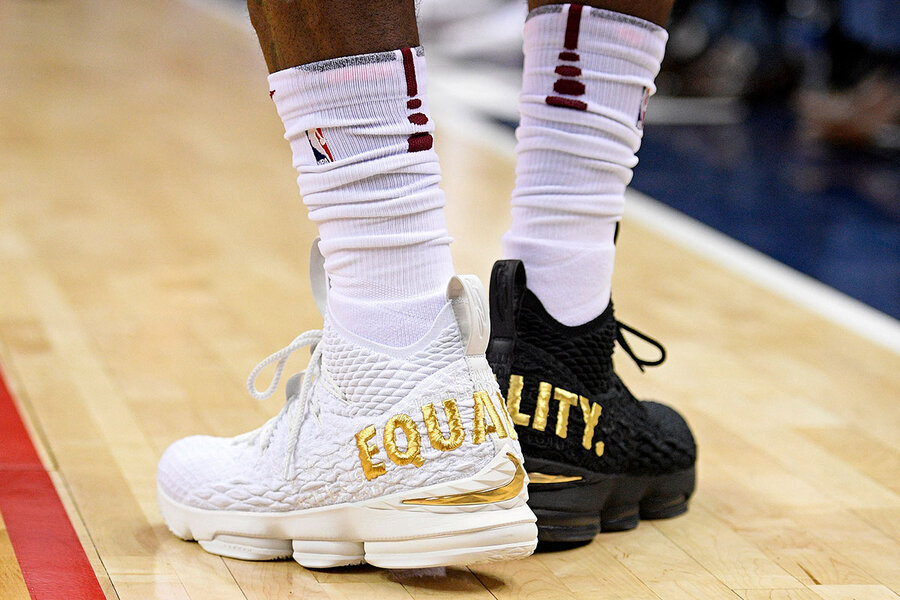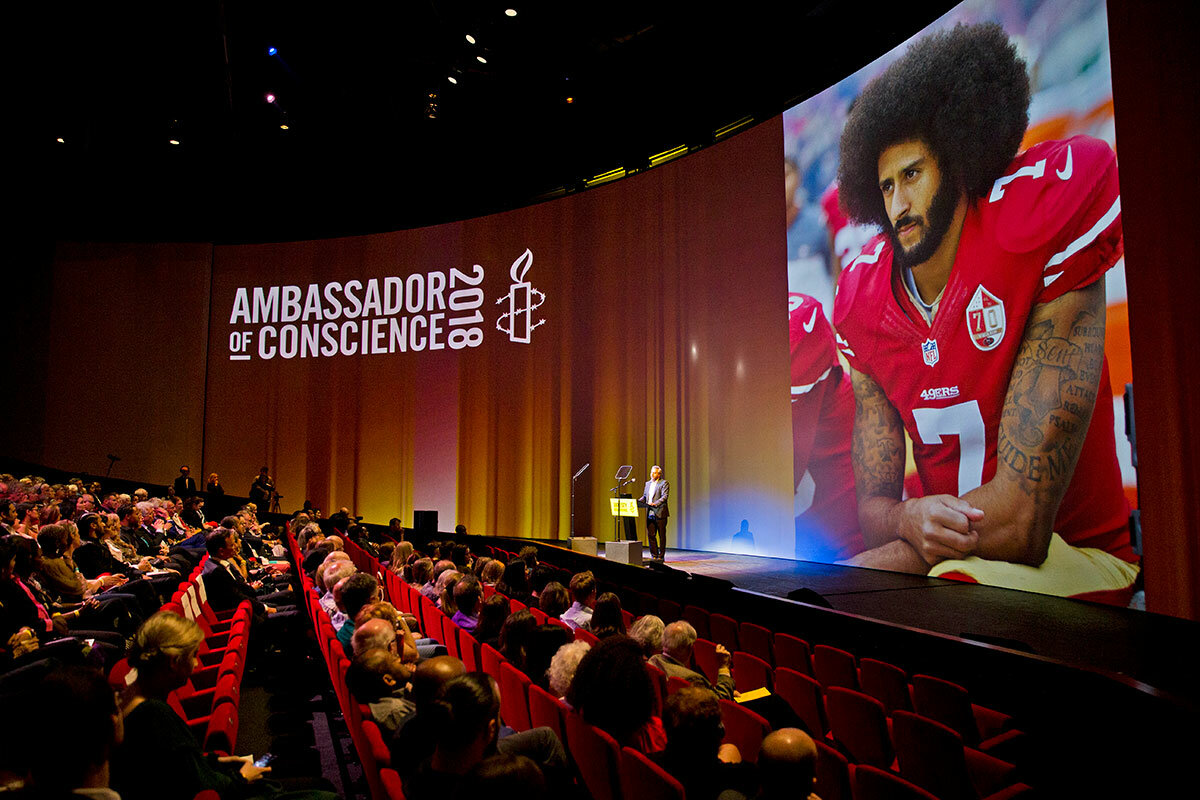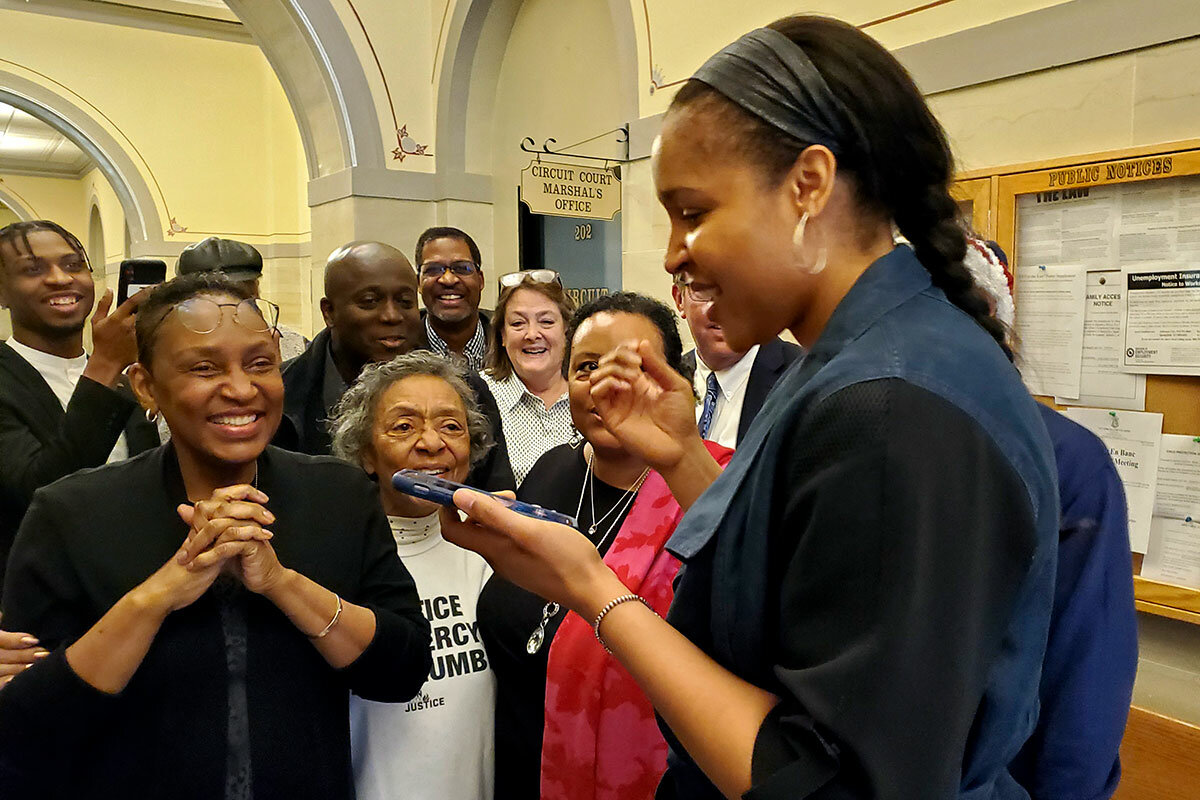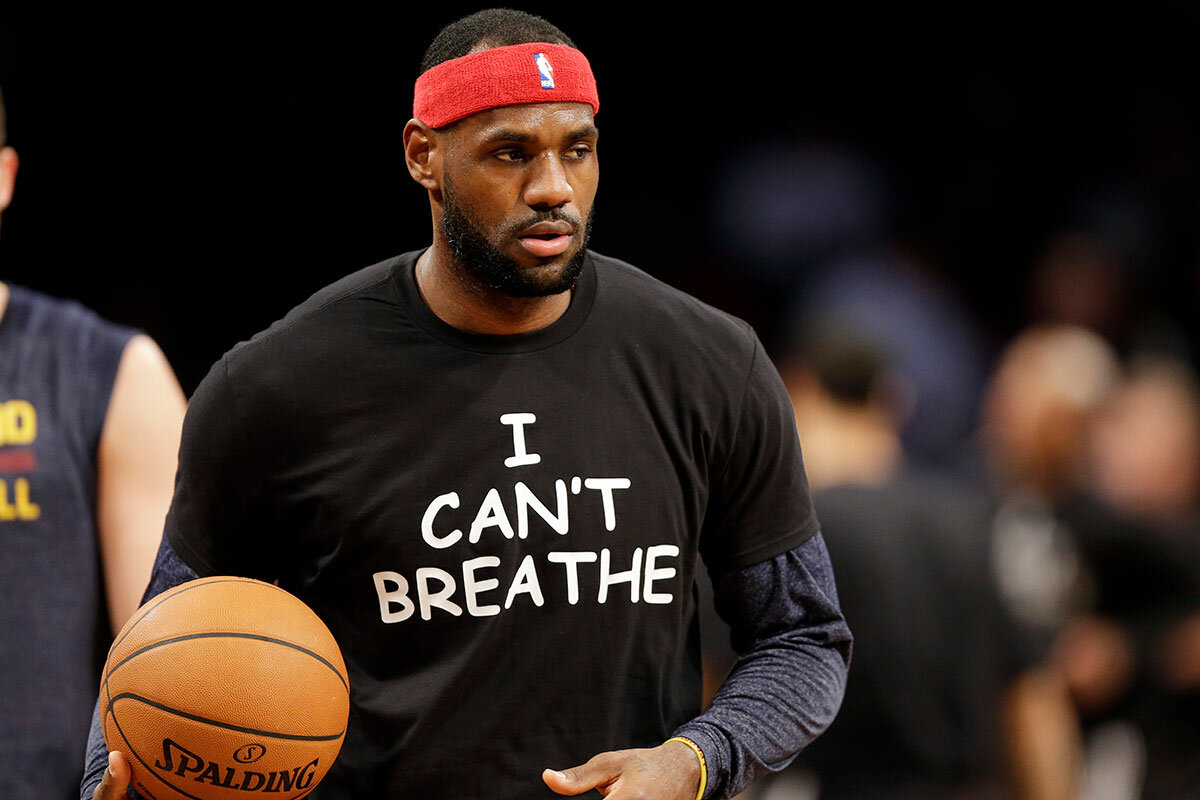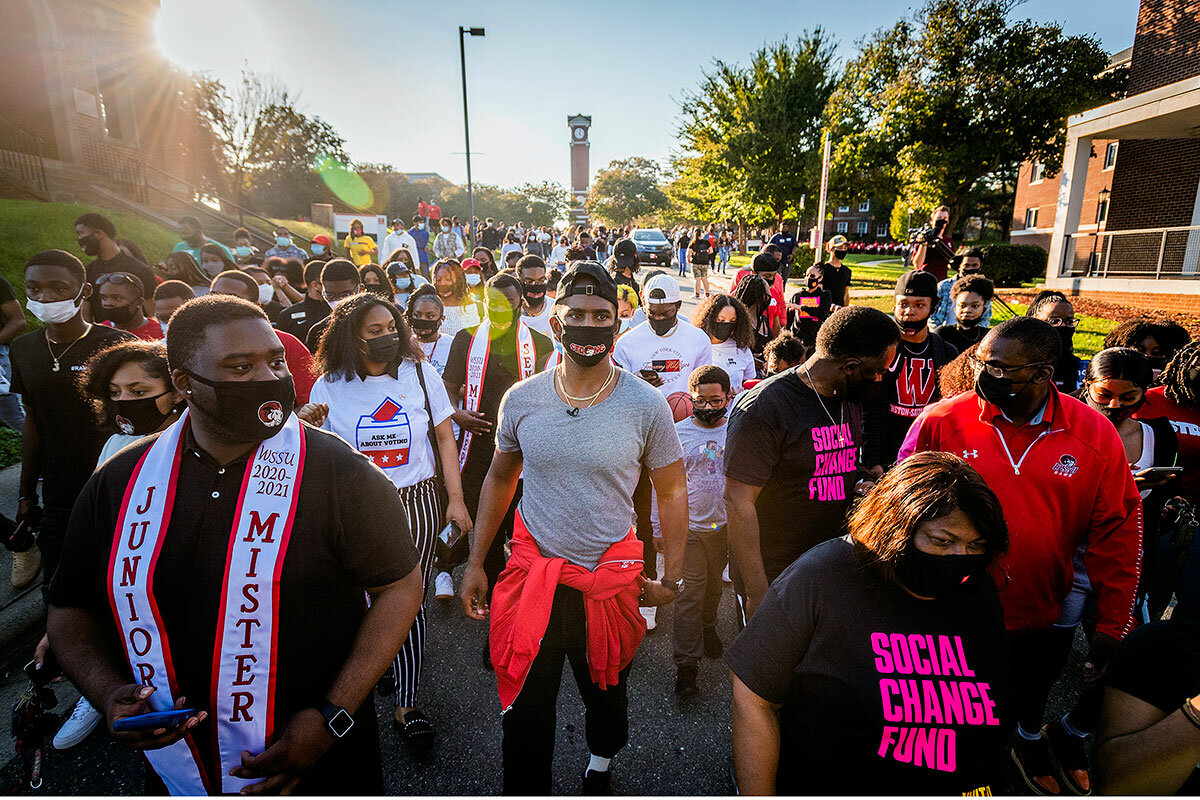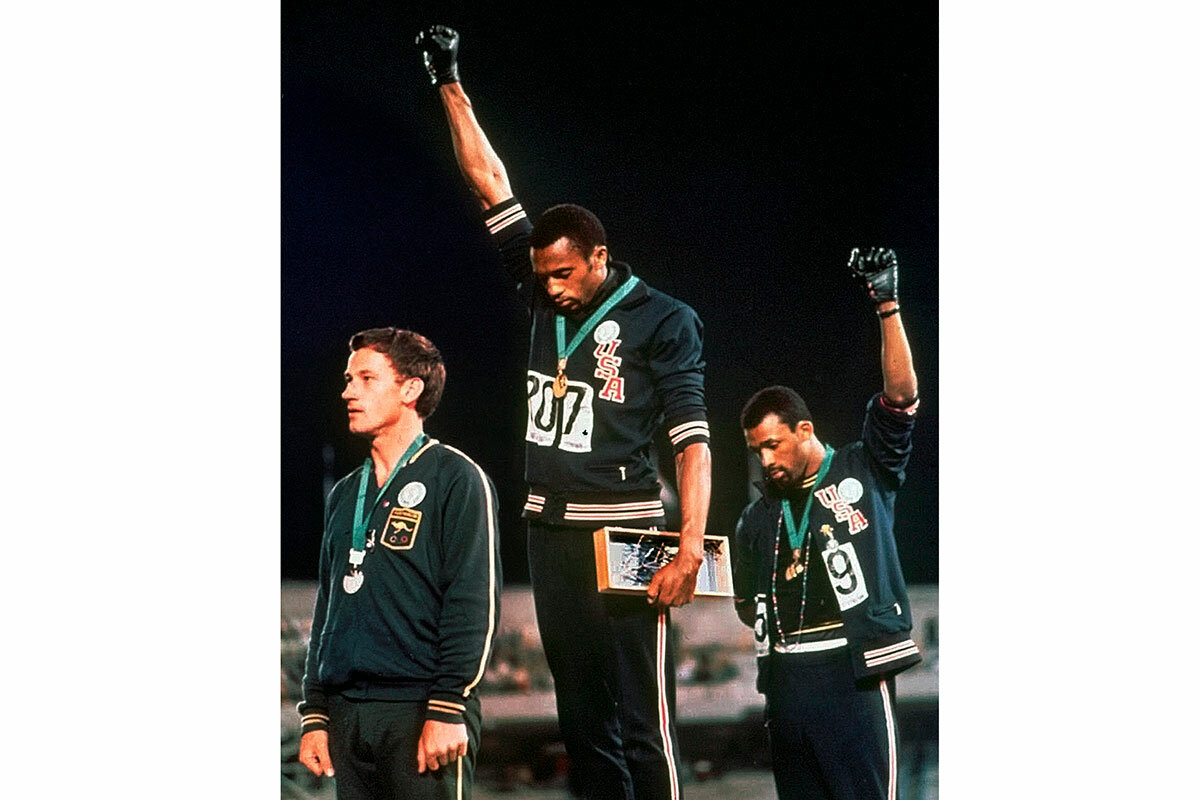Athletes have taken social stands before. Why this time is different.
Loading...
| San Francisco
In a contest that was coming down to the wire, it was only natural to turn to an athlete who was famous for coming through in the clutch. The competition was the 1990 Senate race in North Carolina, a heated, racially divisive match between Harvey Gantt, a Democrat and the first African American mayor of Charlotte, and the longtime Republican incumbent, Jesse Helms, a pillar of the ultraconservative wing of the party.
A famously staunch segregationist, Mr. Helms had strongly opposed the movement to create a national holiday in honor of Martin Luther King Jr., and some of his TV ads during the campaign had played to white racial resentment. One of them showed a close-up of a pair of white hands crumpling up a job applicant’s rejection letter, with a voice-over saying the person had lost out on the position to a less-qualified African American because of racial quotas in hiring.
In the final weeks of the campaign, polls showed that the underdog Mr. Gantt had a realistic chance of unseating Mr. Helms, and it was obvious that an endorsement from Michael Jordan, the former University of North Carolina basketball star who had gone on to international fame with the Chicago Bulls of the National Basketball Association, might put Mr. Gantt over the top. But when asked to come out publicly in favor of the Democrat, Mr. Jordan declined. He had become a successful Nike pitchman, making millions by appearing in commercials and print ads that had sent the sales of the company’s athletic gear soaring. It wouldn’t be prudent to support Mr. Gantt and risk alienating Mr. Helms’ supporters, Mr. Jordan said, because “Republicans buy sneakers, too.”
Why We Wrote This
While athletes have long pushed political causes, the current wave of activism may prove more effective than most. That’s because athletes now make more money, insulating them from nervous sponsors, and they’re backed more by owners, leagues, and the public.
There is no telling whether Mr. Jordan’s endorsement would have made the difference in the election, which Mr. Gantt lost by about 107,000 votes. But for years to come, those four words from Mr. Jordan – which he later insisted he said merely as a joke – would cement the perception of athletes as rich celebrities more interested in their pocketbooks than politics, afraid to support candidates or wade into issues of race or culture.
Gone were the politically and socially conscious athletes of the 1960s and ’70s, when Muhammad Ali was stripped of his boxing title because he refused to serve in the Vietnam War after being drafted into the Army, and John Carlos and Tommie Smith became pariahs for raising their fists in a Black Power salute on the medal stand at the 1968 Olympics in Mexico City. Athletes of the 1990s and 2000s, the thinking went, were too wealthy to care about life beyond their gated mansions. There was too much money at stake for sports stars to risk driving away potential customers or sponsors by choosing sides in any public debates.
If that perception was ever accurate – and in truth, it was always at least somewhat exaggerated – it certainly isn’t any longer. There has been a resurgence of athletic activism in America, particularly by Black athletes, not seen since those turbulent days of the civil rights and Vietnam War eras.
The first stirrings of the movement came in 2010, after the killing of Trayvon Martin, an African American teenager who was followed and ultimately shot in Sanford, Florida, by a neighborhood watch member who found him suspicious even though he was merely walking home from the store. As a form of protest, the Miami Heat of the NBA took a team photo with every player wearing a hoodie similar to the one Trayvon was wearing when he was shot, their way of commenting on the injustice of a Black teen being considered dangerous merely for wearing a hooded jacket.
But it was Colin Kaepernick’s kneeling during the national anthem in 2016, in protest of police shootings of African Americans, that appears to have triggered the full reawakening of athletes’ social conscience. “That was the moment where I said, I don’t want to just tweet. I don’t want to just wear a T-shirt with some words of protest,” says Malcolm Jenkins, a New Orleans Saints defensive back who co-founded the Players Coalition, an organization of National Football League players devoted to social causes, including racial inequities in the criminal justice system. “I want to do something that truly makes a difference.”
Hundreds of players clearly feel the same way. Athletes in nearly every sport have stepped forward in a variety of ways to address what they consider to be social injustices, including but not limited to the deaths of George Floyd and Breonna Taylor at the hands of police. Current and former NBA players like Carmelo Anthony, Stephen Jackson, and Damian Lillard marched in protests following the Floyd killing, in which a Minneapolis police officer held him down with a knee on his neck for 8 minutes and 46 seconds. Chris Paul and LeBron James spearheaded efforts to get out the vote before the presidential election, particularly among young African Americans.
Women’s National Basketball Association players formed a Social Justice Council in June and partnered with the Say Her Name campaign to dedicate their season to Ms. Taylor. One of the league’s biggest stars, Maya Moore, stepped away from the sport indefinitely last year to help overturn the conviction of Jonathan Irons, who had spent 22 years in prison on a burglary and assault conviction. Mr. Irons was released in July and he and Ms. Moore, now a married couple, are working to earn the release of other wrongly convicted prisoners.
Defensive lineman Michael Bennett, a 13-year NFL veteran, retired from football in July in order to devote more time to social justice efforts, including working with Athletes for Impact, a group that encourages sports figures to get involved with worthy causes. “The idea is that not every athlete has to be another Colin Kaepernick,” Mr. Bennett says. “There are any number of ways, big and small, for athletes to bring about change in their communities.”
The activism goes beyond the ceremonial. Mr. James, the Los Angeles Lakers star, joined with other current and former NBA and WNBA players, including Skylar Diggins-Smith, Trae Young, and Jalen Rose, to start More Than a Vote, an organization aimed at inspiring more African Americans to register and cast their ballot in the presidential election.
These new athlete-activists “are courageous, high-profile players who have access to millions of people with a push of the button thanks to social media,” says Etan Thomas, a former NBA player and author of the book “We Matter: Athletes and Activism.” “They are ready and willing to risk fame, fortune, and endorsements, and to endure criticism to stand up for what they believe in.”
Turning points
A variety of factors have contributed to the rise in athletes’ willingness to become politically active. Like many Americans, they have been motivated to push back against the conservative policies of the Trump administration and the inflammatory rhetoric of the president, who said that NFL players who refused to stand for the anthem should be kicked out of the league.
Days after President Donald Trump made those comments in a December 2017 speech, tight end Julius Thomas knelt during the anthem for the first time. “After I heard the president’s comments, it really struck me,” Mr. Thomas told CNN. “I was truly hurt. I don’t think a lot of people know what it feels like to wake up in this country and not feel equal.”
Player protests and other forms of activism have also been met with greater public acceptance than they were decades ago, which may be partly due to the changing demographics of the country. The U.S. population is more ethnically and racially diverse than the one Mr. Ali and others dealt with generations ago. “An audience that includes more people of color and other groups who know what it is to be on the margins is going to be more receptive to protest and activism,” says sociologist Harry Edwards, a longtime political activist who has worked with scores of athletes on social justice causes.
With that public acceptance has come support from the athletes’ teams and leagues, which once resisted and sometimes even punished player protests. In 1996, Denver Nuggets guard Mahmoud Abdul-Rauf refused to stand for the national anthem before games, saying that the American flag was a symbol of oppression and that the United States had a long history of tyranny. The NBA suspended him without pay for a game, costing him more than $31,000. But that was clearly another era. When the league resumed play in August after delaying the season due to the COVID-19 pandemic, not only did most of the players take a knee during the anthem as a form of protest with the league’s blessing, but the courts had “Black Lives Matter” painted on them. NBA Commissioner Adam Silver also allowed the players to have league-approved phrases on the back of their uniforms, including “How many more?,” “Equality,” and “Respect Us.”
NFL Commissioner Roger Goodell, who had offered little support of Mr. Kaepernick after the quarterback began protesting, made a full reversal in August, offering a public apology to him and saying, “I wish we had listened earlier, Kap, to what you were kneeling about and what you were trying to bring attention to.”
The National Collegiate Athletic Association also allowed players to wear phrases promoting social justice on their helmets, and Major League Baseball gave its approval to teams stenciling “Black Lives Matter” on their home fields, as well as providing players with BLM T-shirts to wear during batting practice. When the baseball season began after a four-month break for the COVID-19 pandemic, dozens of players, including All-Stars Mookie Betts of the Los Angeles Dodgers and Aaron Judge of the New York Yankees, knelt during the national anthem, with the league’s blessing.
Players have sometimes tried to take action with fully planned protests, and sometimes with impromptu moves driven by the emotion of the moment. For instance, less than an hour before their NBA playoff game against the Orlando Magic in August, the Milwaukee Bucks decided not to play, in protest of the police shooting of Jacob Blake in Kenosha, Wisconsin, the day before. Within a few hours teams followed their lead, forcing the postponement of eight playoff games over two days. The same day, the New York Mets and Miami Marlins made a statement by taking the field for their game, then walking off and placing a Black Lives Matter T-shirt over home plate as they left.
From backlash to endorsements
Although most of the high-profile athletes who have taken political stands have done so in support of liberal causes and politicians, some well-known sports figures have stepped forward on the right, as well. Legendary golfer Jack Nicklaus posted a lengthy letter of support for President Trump on Twitter 10 days before the election, and former NFL quarterback Jay Cutler retweeted it with his own message that said, “Sign me up.” Former Florida State coach Bobby Bowden was hospitalized for a week after contracting COVID-19 in October, but made it clear that his confidence in the president was unshaken. After his release from the hospital, he released a letter saying that one of the motivating factors in his recovery was that he “wanted to be around to vote for President Trump.”
But most of the athletes who have taken a political stand have done so for more liberal politicians and causes. In some rare cases, like Mr. Kaepernick’s, they have found that their activism can make them more, rather than less, attractive to corporate America. Even though he hasn’t played in an NFL game since 2017, Mr. Kaepernick was popular enough that Nike signed him to a multimillion-dollar deal last year that included Kaepernick-branded shoes and apparel, as well as an ad campaign that kicked off last fall, complete with a national TV spot that showed images of him and other athletes protesting. “Believe in something,” the tag line said, “even if it means sacrificing everything.”
The greater support and acceptance doesn’t mean that athletes are now free of criticism for their activism. In fact, some detractors now charge that players are becoming more politically involved in order to raise their profile and their off-field income. “Told y’all from Day One this was about money,” sports columnist Jason Whitlock tweeted the day after Mr. Kaepernick’s new Nike deal was announced. “All of it.”
It is hard to imagine, though, that Mr. Kaepernick could have foreseen that his protest would lead to financial gain, not when he was initially vilified by much of the public and unable to get a contract offer from a single NFL team after he left San Francisco.
In general, players still face enough backlash that being politically active is no easy decision. They open themselves up to bashing by President Trump or being told to “shut up and dribble,” as Fox News television host Laura Ingraham advised Mr. James and Kevin Durant after they criticized the president in a TV interview.
A fourth wave
That sort of criticism is nothing new. There is a long history of Black athletes who have tried to make a social impact being met with harsh resistance. Dr. Edwards, a professor emeritus at the University of California, Berkeley, frames the history of athletes’ activism in terms of “waves.”
In the first wave he includes athletes of the 1920s and ’30s, such as boxers Jack Johnson and Joe Louis and track star Jesse Owens, who represented the fight to establish Black athletes as legitimate in the eyes of white fans. Post-World War II players like Jackie Robinson and Larry Doby (baseball), Kenny Washington (football), and Chuck Cooper (basketball) broke color lines in their respective sports, not only bringing about desegregation in athletics but helping to prime the pump for the civil rights movement.
The third wave encompasses the Black Power and civil rights movements of the 1960s when athletes like Mr. Ali, football’s Jim Brown, and NBA star Bill Russell of the Boston Celtics spoke out defiantly about racism and social justice in America. It earned them condemnation and a reputation as angry Black men in many circles. It may have been the criticism those athletes received that made their successors, players like Mr. Jordan, less willing to engage in controversial issues.
In Dr. Edward’s view, the U.S. is now in the midst of a fourth wave in which athletes are bringing their financial independence and social influence to bear. Will the movement last? Will it make a permanent impact on the political future of the country? That’s as hard to forecast as whether a college superstar will be successful in the pros. Circumstances change, distractions arise, news cycles move on to the next headline.
Yet the climate for athletic activism has certainly never been more welcoming. There may not be many team owners and league executives hoisting protest banners, but their players’ passion appears to have motivated them to become more engaged civically and politically than ever before. One example of that is the number of stadiums, arenas, and athletic facilities that teams made available to be COVID-19 testing places and polling places for the November election.
It’s unlikely this wave of political involvement will subside anytime soon. This generation of professional players is the wealthiest in history, which means they have the financial security to continue their efforts even if it means some reduction in earning potential. Beyond that, they have discovered that their voices can make change, however incremental.
They will also be inspired to push on because they can see the impact they are having on an individual level. Consider how Emerald Snipes, daughter of Eric Garner, who died after being locked in a chokehold by police in New York, reacted when she saw various NBA players wearing “I Can’t Breathe” T-shirts over their uniforms in honor of her father as they warmed up for their games.
As Etan Thomas quoted her in his book on athlete activism: “I was completely overwhelmed because ... I’m just this regular person from New York and you want to support me? Going against the dress code of your job, risking your livelihood, how you support your family and you’re risking all of that for my father? I was so thankful to them for doing that because I’m sure there were people telling them not to, that it would be bad for their image or that it may upset their fan base or affect their endorsements or whether a team would pick them up the following season. In spite of all that, they made this public statement for my father and words cannot express how thankful I am.”
It is true that political activism runs in cycles, and athletes may not maintain their current level of engagement indefinitely. But each cycle of voices makes it easier for the next one to be heard.




